Turns out we’ve all vastly overemphasized the getting-stronger-and-faster part of being fit. The real secret to optimal performance is taking care of yourself—starting with getting a better night’s sleep.
Safeguard Your Sleep
Sleep is important—we know this. Don’t get enough and we’re prone to being crabby, becoming sick, and underperforming as athletes. Worse, we now know that catching up on rest isn’t really possible. “If you lose sleep one night, there is a chance you can recover that deficit with one good night’s sleep,” says Holden MacRae, a sleep specialist and professor of sports medicine at Pepperdine University. “But if it’s more than one night, you will have lost that sleep for good—you’ve already done the damage.” For athletes, better Z’s starts with three basic steps:
Adopt a Kindergartner’s Bedtime
The number-one thing you can do to maximize the health benefits of sleep, no matter how much you’re getting, is go to bed earlier—a lot earlier. “That old adage about every hour you sleep before midnight being worth two after midnight is true,” says MacRae. The reason? No matter when you go to bed, the closer it is to sunrise, the more likely you are to have dream-heavy REM sleep, which is less restorative. MacRae
recommends a bedtime that ensures you’re asleep by around 9:30 P.M., pointing to research that suggests hitting the sack earlier is much more important than the total number of hours you’re out. “There is no good science that says we must have seven to eight hours,” says MacRae. “Getting quality deep sleep and limiting the number of sleep interruptions is much more important.”
Skip the Evening Intervals
Regular intense exercise absolutely promotes better sleep—but only if you’re doing it at least three to five hours before bedtime. “Hard training always causes your nervous system to react stronger to stimulus,” says MacRae, “which will make it that much more difficult to fall asleep.”
Choose Z’s Over Reps
If you’re suffering from a serious sleep deficit, it’s often best to temporarily cut workouts altogether. “There is no benefit from the training anyway,”
MacRae explains. “You’re in a hole, as they say, and you don’t have the capacity to respond to that added stress.” Getting back to a healthy place requires the discipline to refrain from any physical exertion, even a long hike or bike ride with friends.
How to Design a DIY Massage
Sports-performance coach Christa Pryor works with everyone from Olympians to NBA players, developing programs that speed recovery and prevent injuries. Among the most common prescriptions she gives to her clients are DIY massages designed to keep muscles supple and joints loose. Her methods have athletes using their own body weight and motion to apply pressure where it’s needed most. Here, she describes how amateurs can tide themselves over until that next deluxe rub-down with four movements that require only a firm ball (like a racquetball or lacrosse ball) and foam roller. “Even if you do only one of these a day, it will help the entire body decompress,” Pryor says.
Tight Spot: IT Band
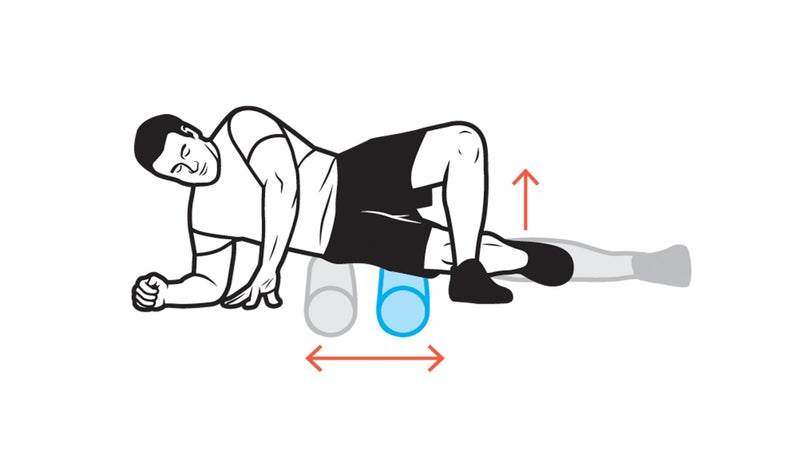
Good For: Runners
Why: “A tight IT band makes you vulnerable to knee tracking issues, foot pain, and over-pronation,” Pryor says. “Keeping it loose will relieve pressure of the hip, knee, and ankle.”
The Move: Roll your IT band (along your outer thigh) on a soft foam roller from the base of the hip to the knee. Once you hit a tight spot, hold the pressure there, exhale into the tension, and bend your knee, moving your heel toward your butt several times. With your knee still bent, move your foot toward the ceiling and then down to the floor several times.
Tight Spot: Neck
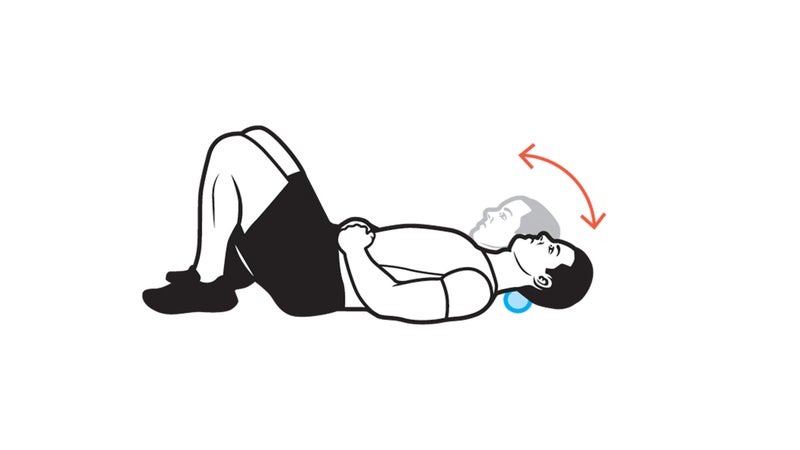
Good For: Climbers, cyclists, smartphone addicts
Why: “When there’s tension at the base of your neural center, it inhibits the speed of all the signals running out to the rest of your body,” says Pryor. “It’s like having an interruption in your brain’s Wi-Fi connection.”
The Move: Lying on your back, with your knees raised to keep your spine flat, place a firm ball at the base of your skull, where it meets your neck. Nod, keeping your neck long, and rotate your head side to side. Move the ball into spots that feel especially tight and repeat.
Tight Spot: Hip Flexors
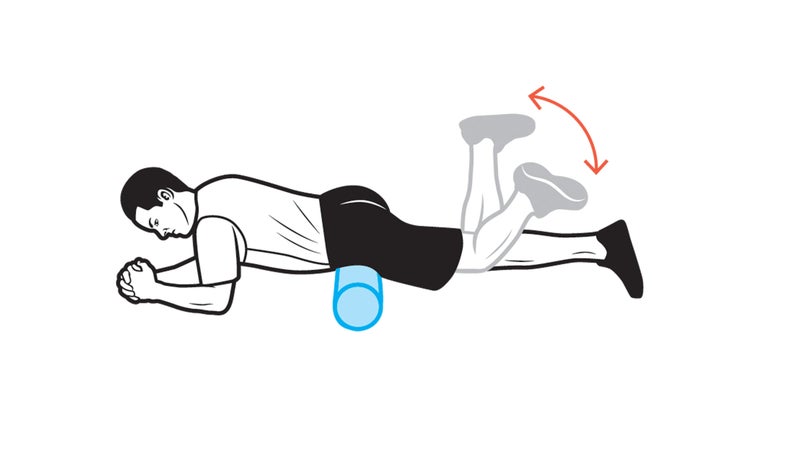
Good For: Cyclists, skiers
Why: “Cyclists are constantly in hip flexion—they never get full extension of their legs—and skiers are always in a crouch,” says Pryor. “By moving the knee as you roll here, you’re elongating the quad and helping your whole body release tension.”
The Move: Facing down, with elbows on the floor, roll the front of your leg on a foam roller from the base of the hip to the knee. Once you find a tender point, exhale into the tension and pull your heel to your glute several times. With your leg up and heel pointed to the ceiling, sweep your lower leg side to side like a windshield wiper.
Tight Spot: Feet
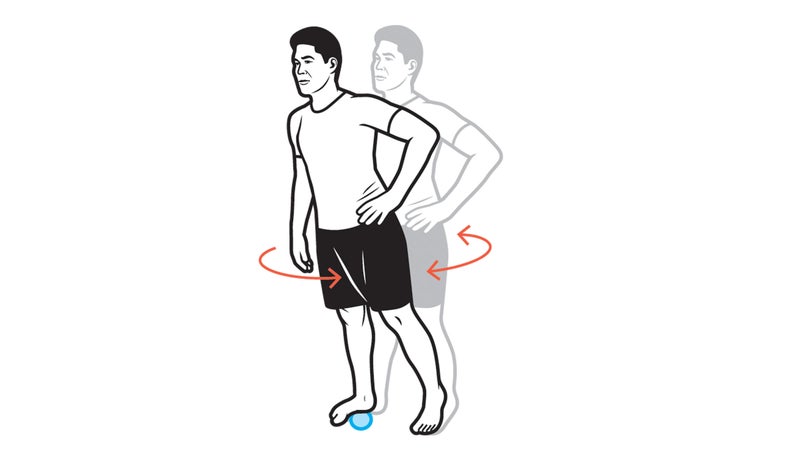
Good For: Everyone
Why: “There are more motor neurons in the foot than anywhere else in the body,” says Pryor. “So one way to release pressure everywhere is to target the foot.”
The Move: Stand with your feet shoulder width apart, and position a ball under your foot at the top of the arch and the base of the pad. With hands on hips, tick-tock your waist from side to side several times. Step the non-ball foot forward 18 inches, and do hip circles in both directions. Switch feet and repeat.
Make Friends with Bugs
To fuel their training or race efforts, many athletes rely on staple meals, snacks, and supplements that have worked for them in the past. But while developing a dependable diet can seem like a competitive advantage, a reliance on the same sources of energy over long periods can diminish the functioning of your whole digestive system by limiting the diversity of healthy gut bacteria. “One of the hidden dangers of an athlete’s diet is that you often don’t have a very wide variety of bugs,” says Teri Tom, a dietitian who works with top professional boxers like Manny Pacquiao and Amir Kahn. “This is especially true if you consume a lot of powders or travel frequently for competitions and stick to the same foods to avoid getting sick.” Tom’s advice: eat a varied diet when you can and follow these guidelines.

Focus on Fermented Foods
“Kimchi, pickled vegetables, kombucha tea, and miso are great examples,” Tom says.
“If you eat a lot of yogurt, make it yourself—in a lot of commercial yogurts, the bugs are no longer alive.”
Add Enzymes
Your body is supposed to produce all the digestive enzymes you need, but many people benefit from enzyme supplements like lipase (for breaking down fats), amylase (for carbs), and protease (for proteins), which boost your ability to absorb nutrients.
Go Light on the Probiotics
They are an effective way to add good bacteria, but overdoing it can lead to gas. And if you have an imbalance, you may need to get rid of some bugs—typically with a botanical treatment or antibiotic—before adding new ones. Think of it as weeding and seeding.
Watch Out for Balloon Belly
Bloating of any kind is a strong sign that something in your digestive system is off. Other clues can be harder to read and don’t always pop up right after you eat. Exhaustion can be the result of a slight intolerance to something you ate a few days ago. Keeping a food journal will help you spot patterns.
Consider a Stool Test
Tom recommends them to about half her athletes. “People often go straight to a blood test, but that only shows your deficiencies,” she says. “A stool test tells you if you’re having trouble absorbing nutrients—you get to the root of the problem.”
The New School of R.I.C.E.
That classic acronym of recovery is still relevant—just not the way you remember. Here, trainer Harry Mitterbauer, a former competitive skier and founder of the Great Earth Performance Center, a high-tech athletic recovery spa in Los Angeles, explains how to reboot the four therapies for the modern era.
Rest
Old School: Get horizontal, preferably with a good book.
New School: Most athletes now know that active recovery—light exercise during a day off—is better than doing nothing, because you’re bringing blood back into muscles. But few realize that the ideal window for active recovery is really tight—within a day of your last hard effort if you’re fit, and never more than two days. Also, the amount of couch time should decrease the fitter you get.
Ice
Old School: Ice-pack as long as you can stand it.
New School: Localized cold therapy for injuries or muscle soreness is most effective when done for short intervals—ten minutes on, ten minutes off—throughout the day. You want to apply the initial cold shock, then let the limb warm up so it can be shocked again.
Compression
Old School: Compression clothing worn during workouts flushes lactic acid.
New School: Compression is best deployed as a post-workout dynamic therapy with an inflatable compression boot or a simple foam roller. The key: do it every day.
Elevation
Old School: Raise limbs when injured to reduce swelling.
New School: Lifting your legs above your heart for 30 to 60 minutes a day promotes blood flow back to your ticker, which enables the body to take care of inflammation no matter where it is. Complete inversion, either hanging upside down or doing a yoga-style headstand, sends more blood to your brain, boosting motor control.
How to Decompress and Rest
“Super-active people have no problem when the prescription is to do more,” says endurance coach Alan Couzens. “But most of them need to be taught to relax.” The only way to achieve peak fitness: take extended breaks while also adopting a more proactive overall approach to rest.
Schedule Downtime
“You need to literally write do nothing on your training calendar,” Couzens says.
Keep Wearing Your Heart-Rate Monitor
Use it to enforce a cap on your heart rate—nothing higher than 50 bpm below your max—so that “easy hike” doesn’t turn into a charge up the mountain.
Go Big
Plan for at least two multi-week vacations from training over the course of a year. Make them sacrosanct. You should also have a month of only low-intensity exercise with minimal structure.
Jonesing to Sweat? Do Yoga.
If you’re supposed to be resting but are dying for a workout, go to a yoga class, preferably one that incorporates meditation. You’ll get your fix with minimal impact, and the flexibility work will pay off down the road.
The Three Best Stretches
Stretching is a chore. And as research has shown, those moves your elementary school PE teacher prescribed don’t do much for you—in fact, they might make you a slower athlete. But dynamic movements can boost performance and prevent injuries. Steve Sudell, a physical therapist and co-owner of Stretch Lab in Venice, California, advocates pre-workout motions that focus on the web of fascia that connect muscles. “Rotational movements in particular incorporate these fascial lines,” he says. “They put your body in a state of preparedness.” If you do only a single stretch, Sudell says to go with one of these three.
The Scorpion
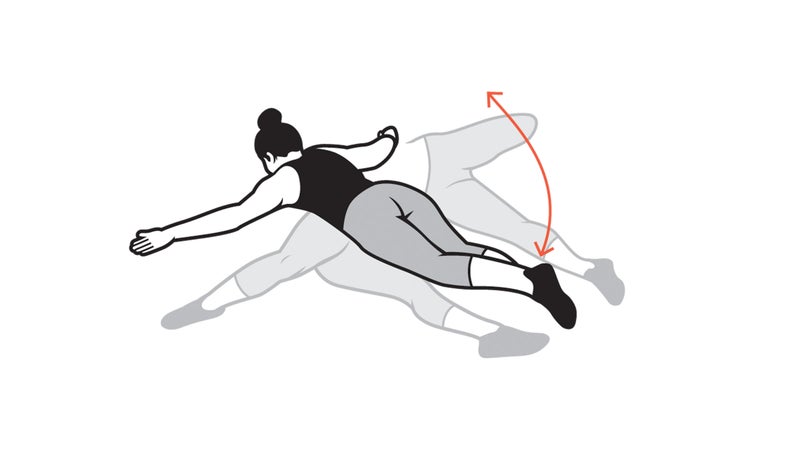
This is especially helpful for cyclists, since they’re in a constant flexed position, which can make the spine, hamstrings, and hip flexors really stiff.
1. Lie on your stomach, with your arms out wide and your feet hip width apart.
2. Bring one foot across your back, as close to the opposite hand as possible. Hold the position for five seconds.
3. Repeat five times each side.
Squat to Hamstring
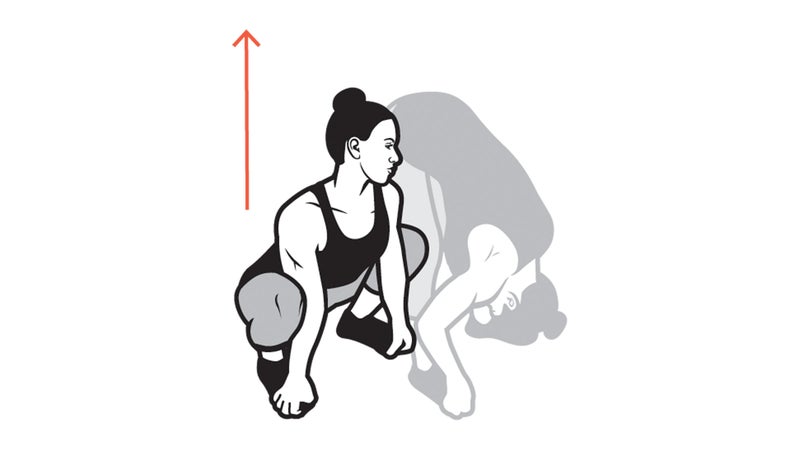
Skiers, CrossFitters, and anyone else doing squats need to open up the knees and hips.
1. Lower into a deep squat, with back flat, knees wide, and butt low, then grab your toes.
2. Straighten your legs, keeping your fingers on your toes until you’re in a forward bend, with your back as straight as possible. Hold for three seconds.
3. Repeat ten times.
Lunge Rotation
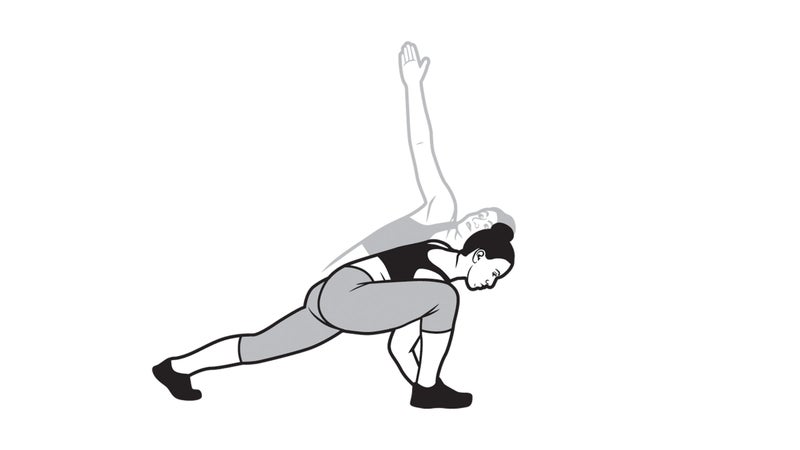
Tight hips, a common problem for runners, can lead to back pain. This move opens the hips and preps your spine for proper rotation and a healthy gait.
1. From a deep lunge position, shoulders low, raise the arm on the same side as your forward leg for five seconds.
2. Bring the arm down, inside your forward knee, touching your elbow to the ground near your foot; hold for five seconds.
3. Repeat five times, alternating sides.


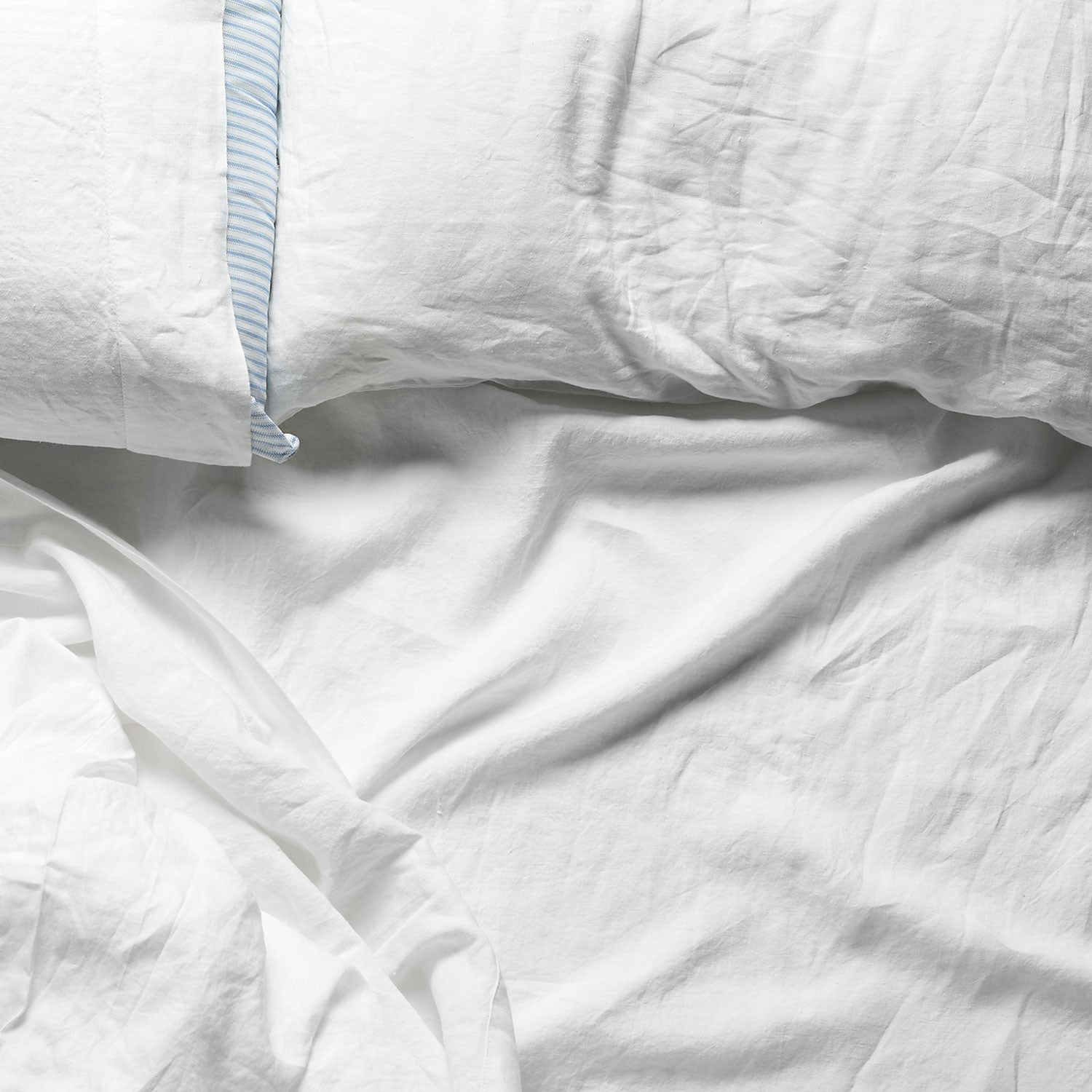
 127 radical tips for total health.
127 radical tips for total health.